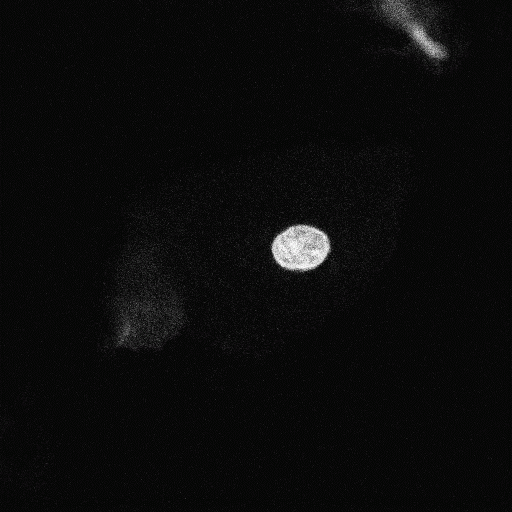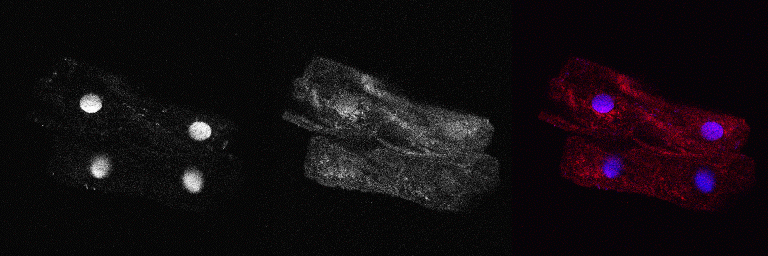Team:Heidelberg/Human Practice/Open Day/Microscopy
From 2008.igem.org
(Difference between revisions)
(→Photo Gallery- Microscopy) |
|||
| (2 intermediate revisions not shown) | |||
| Line 463: | Line 463: | ||
</body> | </body> | ||
</html> | </html> | ||
| + | <br> | ||
=='''Photo Gallery- Microscopy'''== | =='''Photo Gallery- Microscopy'''== | ||
<br> | <br> | ||
Here you get an impression on what the pubils explored in the microscopy station. [ [[Team:Heidelberg/Human_Practice/Open_Day| ''back to previous page'']] ] | Here you get an impression on what the pubils explored in the microscopy station. [ [[Team:Heidelberg/Human_Practice/Open_Day| ''back to previous page'']] ] | ||
| - | + | <br> | |
| + | Cells taken from the oral mucosa are stained with Hoechst and Lysotracker Red in salt-buffer (Krebs-Henseleit). Hoechst is a blue fluorescend dye intercalating into the minor groove of the DNA, thus visualizing the nucleus. Lysotracker Red consists of a red fluorophore coupled to a weak base that accumulates in acidic organelles like lysosomes. A Leica TCS SP5 confocal microscope is used for image aquisition. | ||
| + | <br> | ||
{| align="center" | {| align="center" | ||
| - | | style="width:120px;" align="right" rowspan="3"| [[image:mchd_bac.gif|thumb|350 px| | + | | style="width:120px;" align="right" rowspan="3"| [[image:mchd_bac.gif|thumb|350 px|Cells of the oral mucosa covered with bacteria (Hoechst stain) ]] |
| - | | style="width:120px;" align="right" rowspan="3"| [[image: | + | | style="width:120px;" align="right" rowspan="3"| [[image:mchd_Mundschleimhaut.gif|thumb|350 px| Cells of the oral mucosa focused to the nucleus (Hoechst stain)]] |
|} | |} | ||
{| align="center" | {| align="center" | ||
| - | | style="width:120px;" align="right" rowspan="3"| [[image: | + | | style="width:120px;" align="right" rowspan="3"| [[image:mchd_MontageBakterien.gif|thumb|350 px| Montage: Cells of the oral mucosa covered with bacteria. Blue color indicates the nucleus and bacterial DNA, Red color stains acidic compartments and gives a diffuse background in the cytosol.]] |
| - | | style="width:120px;" align="right" rowspan="3"| [[image: | + | | style="width:120px;" align="right" rowspan="3"| [[image:mchd_MontageMundschleimhaut.gif|thumb|350 px| Cells of the oral mucosa focused to the nucleus. Blue color indicates the nucleus and bacterial DNA, Red color stains acidic compartments and gives a diffuse background in the cytosol.]] |
|} | |} | ||
{| align="center" | {| align="center" | ||
| - | | style="width:120px;" align="right" rowspan="3"| [[image: | + | | style="width:120px;" align="right" rowspan="3"| [[image:mchd_Group1.gif|thumb|350 px| Group 1: Hoechst stain of cells from the oral mucosa]] |
| - | | style="width:120px;" align="right" rowspan="3"| [[image: | + | | style="width:120px;" align="right" rowspan="3"| [[image:mchd_Group2.gif|thumb|350 px| Group 2: Hoechst stain of cells from the oral mucosa]] |
|} | |} | ||
{| align="center" | {| align="center" | ||
| - | | style="width:120px;" align="right" rowspan="3"| [[image: | + | | style="width:120px;" align="right" rowspan="3"| [[image:mchd_MontageGroup1.gif|thumb|350 px| Montage group 1: Blue color indicates the nucleus and bacterial DNA, Red color stains acidic compartments and gives a diffuse background in the cytosol.]] |
| - | | style="width:120px;" align="right" rowspan="3"| [[image: | + | | style="width:120px;" align="right" rowspan="3"| [[image:mchd_MontageGroup2.gif|thumb|350 px| Montage group 2: Blue color indicates the nucleus and bacterial DNA, Red color stains acidic compartments and gives a diffuse background in the cytosol.]] |
|} | |} | ||
{| align="center" | {| align="center" | ||
| - | | style="width:120px;" align="right" rowspan="3"| [[image: | + | | style="width:120px;" align="right" rowspan="3"| [[image:mchd_Group3_1.gif|thumb|350 px| Group 3: Hoechst stain of cells from the oral mucosa]] |
| - | | style="width:120px;" align="right" rowspan="3"| [[image:mchd_Group3_2.gif|thumb|350 px| | + | | style="width:120px;" align="right" rowspan="3"| [[image:mchd_Group3_2.gif|thumb|350 px| Group 3: Hoechst stain of cells from the oral mucosa]] |
|} | |} | ||
{| align="center" | {| align="center" | ||
| - | | style="width:120px;" align="right" rowspan="3"| [[image: | + | | style="width:120px;" align="right" rowspan="3"| [[image:mchd_MontageGroup3_1.gif|thumb|350 px| Montage group 3: Blue color indicates the nucleus and bacterial DNA, Red color stains acidic compartments and gives a diffuse background in the cytosol.]] |
| - | | style="width:120px;" align="right" rowspan="3"| [[image: | + | | style="width:120px;" align="right" rowspan="3"| [[image:mchd_MontageGroup3_2.gif|thumb|350 px| Montage group 3: Blue color indicates the nucleus and bacterial DNA, Red color stains acidic compartments and gives a diffuse background in the cytosol.]] |
|} | |} | ||
<br> | <br> | ||
[ [[Team:Heidelberg/Human_Practice/Open_Day| ''back to previous page'']] ] | [ [[Team:Heidelberg/Human_Practice/Open_Day| ''back to previous page'']] ] | ||
Latest revision as of 08:35, 29 October 2008


Photo Gallery- Microscopy
Here you get an impression on what the pubils explored in the microscopy station. [ back to previous page ]
Cells taken from the oral mucosa are stained with Hoechst and Lysotracker Red in salt-buffer (Krebs-Henseleit). Hoechst is a blue fluorescend dye intercalating into the minor groove of the DNA, thus visualizing the nucleus. Lysotracker Red consists of a red fluorophore coupled to a weak base that accumulates in acidic organelles like lysosomes. A Leica TCS SP5 confocal microscope is used for image aquisition.
 "
"











